INOWAS
Um sistema baseado na web para apoiar a implementação bem sucedida dos métodos de Recarga Gerida de Aquíferos
INOWAS
Voltar
Download the practice
People in charge of the innovative practice :
Não conhecido
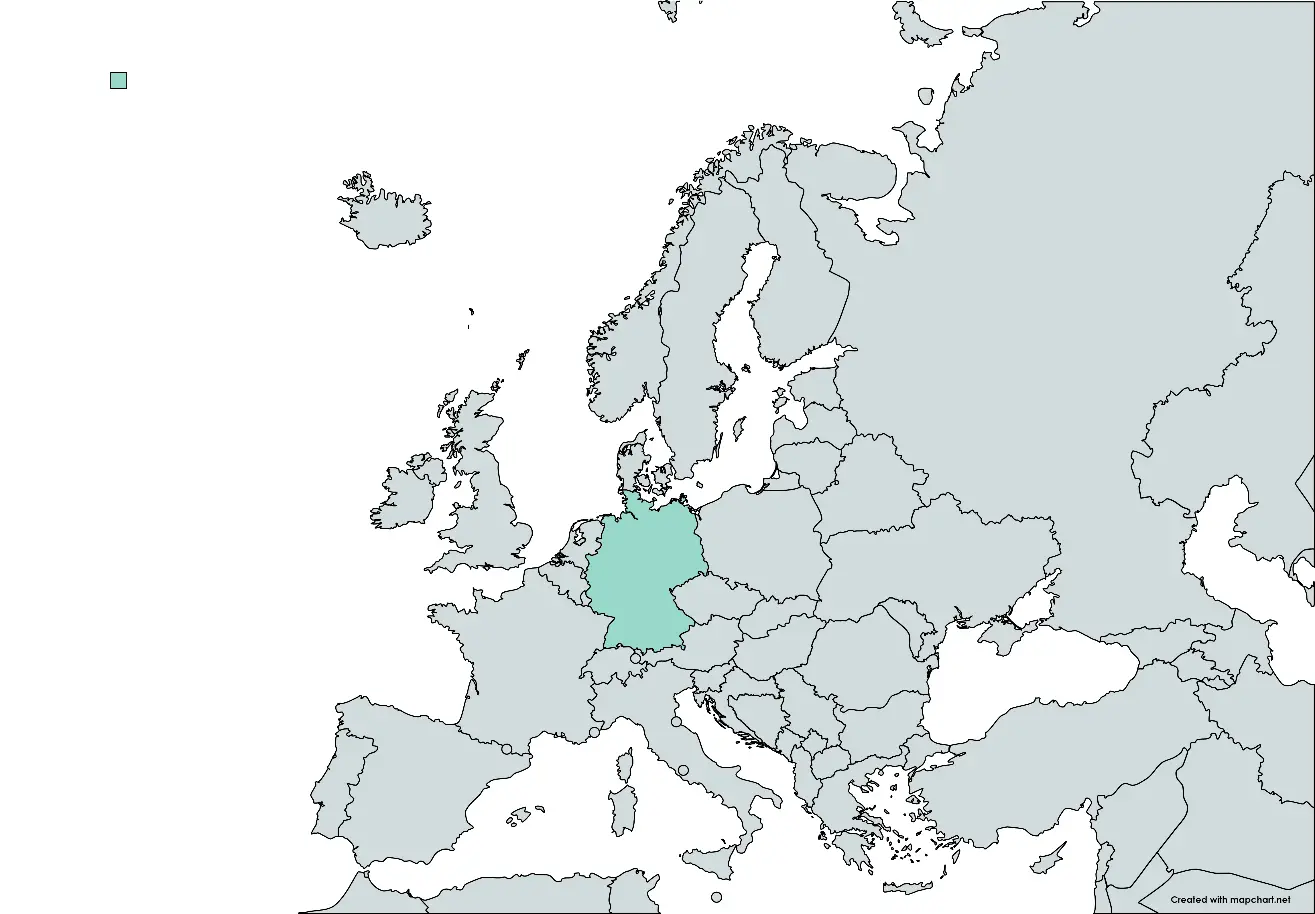
Responsible entity
The INOWAS platform was developed within Dresden Technical University (TUD), by the Managed Aquifer Recharge (MAR) Junior Research Group – the INOWAS Group (Fig. 1). This is a research unit under the Department of Hydrosciences of the Faculty of Environmental Sciences at TUD.

The INOWAS team is composed of 18 persons from 12 different countries and has been continuously engaged in international networking since its creation in 2014. Among the contacts established, INOWAS, has active networking with international associations such as IAH, UNESCO Institute for Water Education or the Australian CSIRO. The group also contributes with lectures to various study courses such as “Hydroscience and Engineering” and “Groundwater and Global Change – Impacts and Adaptation” and has promoted a series of international summer schools since 2016.
The group is currently led by Catalin Stefan. and is responsible for the development of the first global inventory of MAR applications in 2015 (Stefan and Ansems, 2018). This survey covered 62 countries and collected information about 1200 case studies concerning historical development, site characterization, operational scheme, objectives and methods used, as well as quantitative and qualitative characterization of in- and outflow of water. This robust database is currently available in UNESCO International Groundwater Resources Assessment Centre’s web map tool.
Detailed explanation
The INOWAS group recognized that most decision support systems for water management are desktop-based, which represented a particular constrain in the and dissemination. The INOWAS platform is developed as an open-access web service where the whole workflow is managed directly in a web browser without the need to install additional plug-ins. This also allows for online multi-user collaboration between researchers and decision-makers bringing a global perspective to water resources management, simplifying communication and making information quickly available everywhere if needed. Users can work on private, public or shared tasks while the work progress is saved at any stage and can be resumed later.
The INOWAS platform includes the possibility to assemble groundwater finite-difference models based on MODFLOW and conduct the simulations calculations directly in the web browser, without the need to install any software. This possibility decreases compatibility issues related to operating systems, which are recurrent in desktop applications, and require no update procedures. While modelling, the workflow is saved at any time and can be continued later from another machine if necessary, using ongoing integration of cloud-based services (which will in the future allow for very complex numerical model simulations). The platform is structured as presented in Fig. 3.
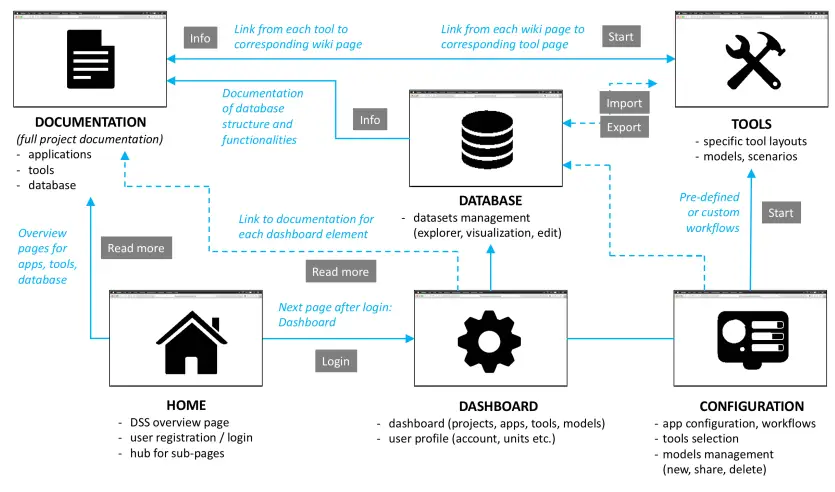
Simulation tools are the strong point of the INOWAS platform. These are hierarchically organized in three types: (1) empirical (derived from data mining such as the global MAR applications inventory or a database for GIS-based MAR site suitability mapping); (2) analytical (based on simple equations for saltwater intrusion assessment, calculation of pumping-induced river drawdown or estimation of groundwater mounding beneath an infiltration basin); (3) numerical (MODFLOW-based simulations using numerical flow and transport models).
In the modelling procedures, the management and analysis of the user-friendly scenario allow for a flexible interpretation of results and future predictions. The set of numerical tools is composed of T20 real-time modelling, T03c variable-density flow (SEAWAT), T07 MODFLOW model scenario manager, T03b solute transport (MT3DMS) and T03 numerical groundwater modelling and optimization.
In its current state, access to the INOWAS platform is free for education and non-commercial purposes, being necessary for the user to create an account. It relies on a very robust set of open-source libraries and platforms (Fig. 4).
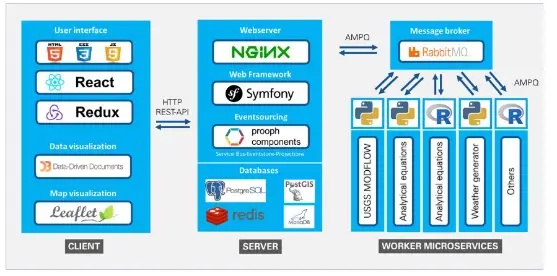
Evidence of benefits from implementation
Due to the nature of the platform presented no palpable benefits are presented. The tools that are comprised in the INOWAS platform were used to evaluate MAR feasibility in several locations (Glass et al. 2017a, Kwoyiga and Stefan, 2019) which resulted in a substantial amount of scientific and technical documentation. It can be concluded due to the present well-developed state of the platform that the foundational project was successfully completed. INOWAS group, through the platform, was successful in performing diagnostic analysis of aquifers, accessing MAR implementation schemes, helping to plan and optimize those schemes, promote sustainable water management, develop stakeholders’ capacities and academic training and most of all lay the path to improving the link between modelling and decision making. It was possible to promote MAR through the development of an integrated knowledge base with detailed descriptions and best-practice examples of most common MAR techniques; and demonstrate MAR benefits through the simulation of multiple management scenarios (Glass et al., 2017b).
Replication potential in SUDOE region
MAR methods showed as an important tool in integrated water resources management, particularly in water scarcity prone areas such as Mediterranean regions. It is therefore fundamental to develop models to evaluate those methods feasibility and prove them both economically and environmentally reliable, being the well documented and tested INOWAS platform an already proven stage for such procedures.
Institutional setting
The main driver of INOWAS research group is MAR, the purposeful recharge of an aquifer for later water recovery or environmental benefits (Dillon et al., 2009; Bouwer, 2002) and has proven to be a reliable instrument for sustainable groundwater management. This concept comprises a series of different methods, from surface spreading methods (i.e., infiltration basins and structures alike) to borehole injection, and each with specific requirements for implementation. Despite its demonstrated economic and ecological benefits, MAR is still not widespread, partly due to poor access to information and lack of knowledge. To help address these challenges INOWAS promoted technical innovation and the development of tools like the INOWAS Platform to plan, assess and optimize MAR applications.
Geographical setting
INOWAS MAR junior research group is sited in Pirna’s TUD TU Dresden external campus. Pirna is 38.252 inhabitant’s town in the German state of Saxony, the capital of the administrative district of Saxon Switzerland-Eastern Ore Mountains. Under the experimental pillar of the INOWAS Group and its main research subject a pilot MAR site was developed in Pirna’s TUD campus. This site is located on the banks of Elbe River and has allowed to conduct various investigations both at laboratory and real scale. The pilot is composed of one rapid infiltration basin to simulate MAR scenarios under natural conditions, seven groundwater monitoring wells to perform tracer experiments and determine groundwater flow direction and velocity (useful for aquifer-storage-recovery methods) and eleven small-diameter piezometers – Fig. 2. All of them are equipped with real-time monitoring devices to collect in-situ parameters whose deep analysis allowed for use as input for calibration of numerical models of the vadose zone (fundamental for MAR).
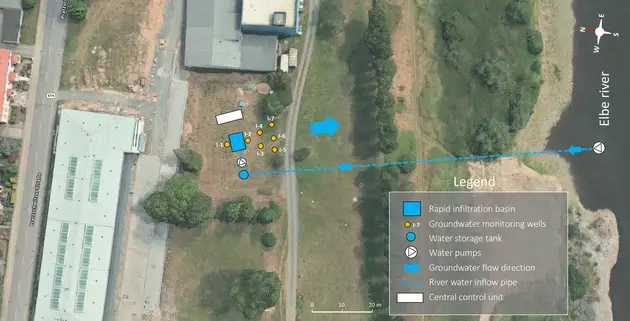
Historical overview
A project with the same name of the platform funded by the German Federal Ministry of Education and Research laid the basis for the INOWAS development. The project was conducted from May of 2014 to April 2019 and, at the time, aimed at providing stakeholders with a scientifically based decision support system (DSS) for planning, design and management of applications in the water sector. The project focus lied on the qualitative and quantitative assessment of groundwater resources by scenario analysis, prognosis and risk assessment and with regard to the influencing climatic factors. The project presented four main pillars (Qualification, Knowledge, Computing and Applications) and was composed of nine work packages (Fig. 5)
The multi-component DSS was then developed on an interactive web-based platform that combined a comprehensive knowledge base with complex scenario analysis tools. A public blueprint of the platform was presented at the 9th International Symposium on Managed Aquifer Recharge (ISMAR9), organised in 2016 in Mexico City (Stefan et al. 2016).
The official public release happened in the last months of 2017 while a series of INOWAS Summer Schools on MAR started in September 2016. The first summer school was attended by 26 participants from 18 countries. In 2017 The 2nd summer school with the duration of two weeks (4-15 September in 2017) was structured in two main parts: (1) Planning and optimisation of MAR schemes and (2) Practical implementation and case studies. A special session was allocated to computer-aided simulation and analysis of different MAR scenarios using the free INOWAS platform (Stefan et al., 2019).
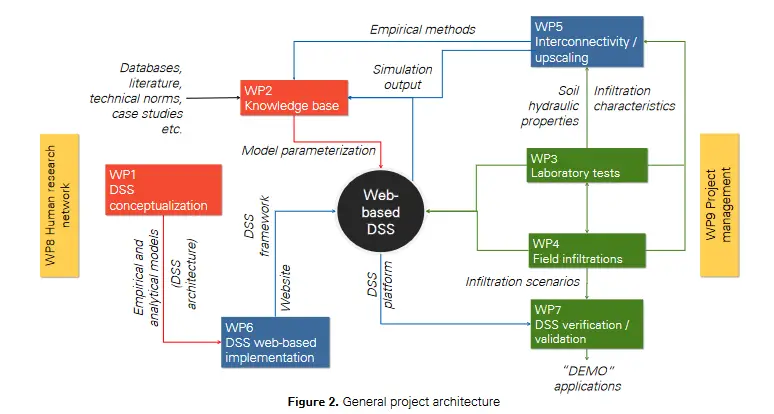
Future outlook
It is expected that INOWAS was the platform for modelling MAR in Kathmandu (Nepal) and for teaching groundwater modelling in Brazil. An important step forward for the platform is the ongoing SMART-Control research project, headed by the INOWAS group and funded through the Water Joint Programming Initiative (WaterJPI) and implemented by nine institutions from Germany, France, Cyprus and Brazil. The main objective is to reduce the risks associated with MAR by the development of real-time monitoring and control system in combination with risk assessment and management tools. The project approach relies on coupling a real-time in-situ observation system consisting of online sensors and a web-based groundwater monitoring and modelling platform. The resulting system shall provide operators and managers of MAR schemes with automatic decision support tools for monitoring, controlling and predicting processes occurring during MAR. The approach will be tested and validated at six MAR sites under different environmental and operating conditions (Glass et al., 2020). The INOWAS platform will be upgraded in the SMART-Control project by four additional simulation tools (Fig. 6):
- T1. Initial risk assessment. to evaluate the viability of a MAR project and the preliminary assessment of human health and environmental risks. with a quantitative microbial risk assessment (QMRA) component consisting of hazard identification, exposure assessment, dose analysis and risks characterisation to predict the risk of infection or disease-related outcome.
- T2. Real-time monitoring and control. to facilitate the operational management of MAR sites by conducting real-time integration of time-series data into the INOWAS modelling platform. Sensors installed at MAR facilities worldwide can be connected to the INOWAS platform to transfer collected data in real-time.
- T3. Automatic groundwater model update and simulations relying on the capabilities of the INOWAS platform enabling fast response and optimized management.
- T4. Predictions for advanced system management to evaluate spatial and temporal water availability under different scenarios such as climate and land-use change.
INOWAS collaborative modelling capabilities will also be the central platform for the forthcoming AgreeMAR project funded by European Union’s PRIMA.

Fig. 6 – SMART-control architecture (adapted from Glass et al., 2020)
Key points of the innovative method
- INOWAS Platform is a free, web-based modelling platform for planning, assessment and optimization of MAR applications
- was developed by a recently assembled research group based at the Technical University of Dresden and is focused on MAR
- The platform allows the integrated use of various model complexities and provides the best accessibility of project data and multi-institutional collaboration through web-based implementation
- makes use of a combination of widely available open-source tools and promotes the case-based analysis approach with support for model parameter estimation and solution finding
- Cloud capabilities are being developed as well as the capacity to analyse real-time data for numerical modelling calibration
Acknowledgements
This innovative practice was suggested by Teresa Leitão from the Portuguese National Laboratory for Civil Engineering – LNEC – after discussion between PPA and LNEC.
References
Bouwer, H., 2002. Artificial recharge of groundwater: hydrogeology and engineering. Hydrogeology Journal 10, 121–142. https://doi.org/10.1007/s10040-001-0182-4
Dillon, P., Pavelic, P., Page, D., Beringen, H., Ward, J., 2009. Managed aquifer recharge. An introduction waterlines report series 13. https://recharge.iah.org/files/2016/11/MAR_Intro-Waterlines-2009.pdf
Glass, J., Stefan, C., Junghanns, R., 2017a. Free MODFLOW-based web modeling framework for planning and assessment of managed aquifer recharge schemes. Presentation at the MODFLOW and More 2017: “Modeling for Sustainability and Adaptation” Conference, Golden, Colorado, USA, 21-24 May 2017. http://igwmc.mines.edu/MODFLOW2017/2017_PROCEEDINGS_MODFLOW-and-More.pdf
Glass, J., Sallwey, J., Junghanns, R., Fichtner, T., Stefan, C., 2017b. Web-based compilation of empirical and analytical equations for the sustainable management of groundwater resources. 44th Annual Congress of the International Association of Hydrogeologists, IAH, Dubrovnik, Croatia. http://dx.doi.org/10.13140/RG.2.2.11414.86083
Glass, J., Junghanns, R., Schlick, R., Stefan, C., 2020. SMART-Control Deliverable D4.2: Web-based real-time monitoring and control capabilities -Implementation of web-based real-time monitoring tool on INOWAS platform. http://dx.doi.org/10.13140/RG.2.2.16843.52007.
Stefan, C., Fatkhutdinov, A., Ringleb, J., Sallwey, J., 2016. Integrated web-based framework for planning and assessment of managed aquifer recharge. 9th International Symposium on Managed Aquifer Recharge – ISMAR9. https://recharge.iah.org/files/2021/02/ISMAR9_book_abstracts.pdf
Stefan, C., 2017. Web-Based Modelling Framework for Planning and Assessment of Managed Aquifer Recharge Application. Presentation for the Dresden Nexus Conference (DNC2017). http://dresden-nexus-conference.org/archive/2017/wp-content/uploads/2017/06/A5-Stefan.pdf
Stefan, C., Junghanns, R., Glass, J., Sallwey, J., Fatkhutdinov, A., Fichtner, T., Barquero, F., Moreno Gómez, M., Bonilla, J., 2017. Free web-based modelling platform for managed aquifer recharge (MAR) applications. https://doi.org/10.13140/RG.2.2.23732.04483
Stefan, C., Ansems, N., 2018. Web-based global inventory of managed aquifer recharge applications. Sustain. Water Resour. Manag. 4, 153–162. https://doi.org/10.1007/s40899-017-0212-6
Stefan, C., Junghanns, R., Glass, J., Sallwey, J., Barquero, F., Fichtner, T., Schönekerl, C., 2019. Using free web-based tools for strengthening capacities and promotion of MAR. 10th International Symposium on Managed Aquifer Recharge – ISMAR10. http://dx.doi.org/10.13140/RG.2.2.16129.10088
INOWAS platform website (https://inowas.com/)
INOWAS project flyer (https://tu-dresden.de/bu/umwelt/hydro/iak/ressourcen/dateien/inowas/dateien/2014/poster_kassel?lang=en)
SMART-control project information (https://www.smart-control.inowas.com)
IGRAC GW Resources Assessment Center MAR Portal (https://ggis.un-igrac.org/view/marportal)
Other sources:
https://tu-dresden.de/bu/umwelt/hydro/inowas/research/projects/inowas
http://en.pirna.de/Home/4188l1/
INOWAS platform participating members:
INOWAS MAR junior research group (https://tu-dresden.de/bu/umwelt/hydro/inowas/about)
Technical University of Dresden (https://tu-dresden.de/)
aquifer
NOTÍCIAS
Descubra mais sobre as notícias do projeto AQUIFER e sobre a gestão de aquíferos
NOTÍCIAS AQUIFER
Descrição e objectivos do projecto
The scientific community recommends a substantial improvement in the knowledge of aquifers, the establishment of reliable monitoring networks and a greater involvement of the administration and users to achieve a sustainable management of aquifers. The main objective...
Informação sobre o projecto
A Comunidade de Utilizadores de Água do Delta Llobregat concebeu bacias de recarga em Molins de Rei para recarregar o aquífero do Baix Llobregat. Vista de uma das bacias de recarga durante a fase de teste A Comunidade de Utilizadores de Água de Llobregat Delta é um...
Histórias de sucesso na gestão das águas subterrâneas
Compilação de histórias de sucesso na gestão das águas subterrâneas. Ao longo do mês de Abril, os 30 casos de práticas inovadoras na gestão das águas subterrâneas já foram seleccionados pelos agrupamentos que participam no projecto: PPA, CWP e AV. A tarefa começou com...
PROPONHA UMA
PRÁTICA INOVADORA
Está a desenvolver ou implementar uma prática inovadora em matéria de gestão de aquíferos e deseja referência-la na plataforma do projeto AQUIFER?
Preencha o formulário e faça uma proposta aos parceiros do projeto AQUIFER.
THE E-BOOK
O Aquífero oferece uma gama de práticas inovadoras de gestão da água. Pode descarregar todas as nossas fichas técnicas aqui.
E-BOOK DE PRÁTICAS INOVADORAS
DOCUMENTAÇÃO
Aprofunde a informação relacionada com a gestão dos aquíferos